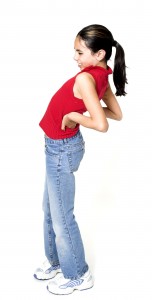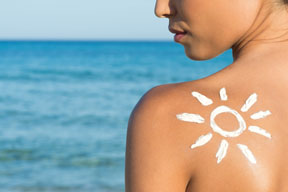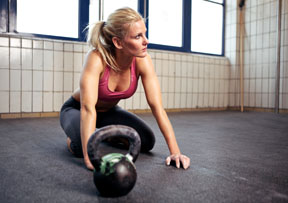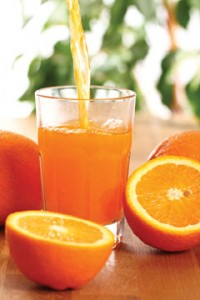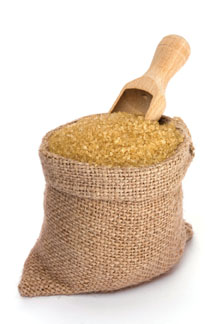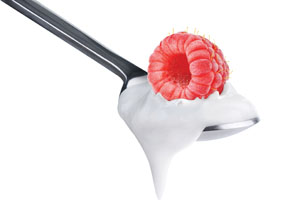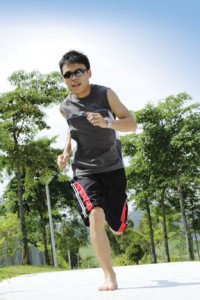“Gameboy” Back – Protecting your Child from the Newest Culprit in Spinal Ailments
By Aly Wagonseller
Anyone that has worked sitting at a computer for years on end knows the havoc it can create on our posture, back and neck alignment. Unfortunately, doctors worldwide are discovering that children as young as eight years old are presenting with adult-like spinal issues not seen since the lack of child labor laws allowed kids to work in factories. Herniated discs, curvature of the spine and an inability to touch their toes is becoming more common, resulting in a generation of children plagued with chronic back problems before they reach the legal age to vote.
Discovering the reason behind this phenomenon is as simple as sneaking a peek at your youngster while playing video games or texting their friends on their smartphones. “Spending hours hunched over gaming devices, tablets and phones is causing a curvature of the spine in many children,” says Dr. Andrew Cash, a Board Certified Orthopaedic Surgeon at Desert Institute of Spine Care. “Increasing numbers of children are developing serious spinal problems such as slipped discs and damaged posture that, in some cases, leads to back pain earlier in life,” he adds. The condition has been nicknamed “Gameboy Back” with a nod to just one of the many offending devices our children use on a daily basis.
What to Do?
Of course limiting the amount of time your child is hunched over tech gadgets would be dreamy, and is a definite possibility for younger children. Yet, as many parents of a tween or teen know, this may not be possible considering the hierarchy these devices play in our child’s daily school, work and social play routines. A more practical solution may be to introduce and practice healthy spine and stretching strategies the entire family can benefit from. Dr. Lovaas from The Joint…The Chiropractic Place in Las Vegas suggests these tips to help maintain a healthy spine now and in the future.
- If your kids are going to play video games, encourage games and game consoles which require movement, like the Nintendo Wii and Xbox Kinect. Games that require movement are better than games that require nothing more than sitting on a couch.
- If you don’t want to rush out and replace your gaming console, consider an inflatable exercise ball. Replace the comfy chair or couch with the ball – this then requires children to engage their core muscles, even when playing video games.
- Micro-breaks from gaming, texting, and computer use are essential for adults and children alike. These breaks allow you to get up and exercise the muscles opposite to the ones you use while sitting. Stand up from that video game, reach your hands above your head and lean back for short stretches. A 30 second stretch every 30 minutes will make a significant difference.
Technology is certainly here to stay, and will only become more important in the future lives of our children. By starting young and starting NOW with techniques to prevent the damaging effects of “Gameboy Back,” we can live comfortably in techie harmony for many years to come.
Safe Grilling for Better Health
By Aly Wagonseller
Throwing a tasty ribeye or rack of ribs onto the backyard barbecue is simply an American institution; especially when local weather is conducive to outdoor cooking nearly 365 days a year. But grilling your meaty meal could be causing more harm to your health than you think. We’re not talking heart disease or high cholesterol here, although they can become a factor if fatty meats are consumed on a daily basis. Rather, this is all about the Big C – Cancer, and the risks are real with every bite you take.
When the combination of protein, intense heat and smoke occurs, substances within meat, chicken and fish form carcinogenic compounds called heterocyclic amines. These compounds, known as HCAs, can actually damage our DNA, allowing for cancer development to start and progress. Most often, these cancers manifest in the colon and stomach, but research suggests that HCAs travel within our systems, causing cancer in other areas of the body, including the breast and prostate regions. Some research even suggests that those who consume large amounts of barbecued red meat such as beef, pork and lamb can double their risk of developing the disease, a meaty fact worth noting. So what can a barbie lover do to reduce the risks and still enjoy a healthy meal off the grill? Hope is in the cooking.
What’s Hot, What’s Not
“Many people enjoy grilling during the summer; however, overcooking meats can actually produce cancer-causing compounds,” says Executive Chef Frank Caputo of Cancer Treatment Centers of America® at Western Regional Medical Center. “We want to share healthy cooking practices for everyone to enjoy.” Caputo, a graduate of the Culinary Institute and a former entrepreneur in the restaurant industry, suggests first seasoning lean meats that include sirloin, flank, tenderloin, veal, poultry and fish with herbs and spices that not only flavor foods but introduce phytochemicals that actually prevent damage of healthy cells. Spices and herbs including cumin, cinnamon and turmeric, as well as cilantro, dill, rosemary and basil are great choices. Incorporating them into marinades along with vitamin C rich citrus juices is a great way to both flavor and tenderize meats. Once you move to the grill, Caputo suggests cooking over low heat, preventing flare-ups at all costs, and avoiding the urge to overcook or burn meats. “Safe temperatures for cooked meats range from 145 degrees for seafood and fish, 160 degrees for ground beef and pork and 170-180 degrees for poultry,” he adds. Other tips to reduce risk include:
- Choose low-fat foods, trim excess fat and incorporate vegetables or kabobs to reduce the chance of HCA formation since fat heated to high temperatures and drip off that creates smoke are major culprits.
- Precook foods in the oven or microwave, finishing on the grill. Research suggests this can reduce HCA formation by 90%.
- Marinate proteins in olive oil and lemon juice-based mixtures. Research shows this reduces the formation of cancer-causing compounds by up to 99% during cooking, while adding flavor and helping to keep foods moist.
- Flip frequently. This may prevent that yummy, caramelized crust we all know and love, but it keeps meat from overheating.
Protecting your family from cancer while enjoying outdoor grilling doesn’t have to be a summer buzzkill. By keeping the flames and smoke at bay and employing a few easy techniques for both cooking and shopping, you’ll be safe, sound, full… and happy!
SunSmart IQ – The Truth About Sunscreen SPF
By Doe Girling
Back in the 1950s and 1960s, sunscreen ad campaigns promoting bronzed, sun-kissed skin started the sun worshipping craze in this country. Remember the ever present Coppertone ads featuring that cute, blond girl with a dog pulling her bathing suit bottom down? Well, the sad truth is that cute blued-eyed girl probably now has leathery skin or is one of the 76,250 people diagnosed annually with malignant melanoma cancer.
Thankfully, we have become more educated in recent years about the importance of wearing sunscreen to avoid getting skin cancer as well as to help our skin age more gracefully. But even with this information, how SunSmart are we? With the rise in skin cancer, manufacturers have hopped on the SPF bandwagon, and over the past several years they have added SPF protection to myriad products. Still, are we being lulled into a false sense of SPF security? Here is some info that may help elevate your Sun IQ.
Rules and Regulations
The sunscreen industry in the United States has unfortunately not changed its standards since the mid 1970s. Manufacturers face little restriction in making claims about their products and do not have to disclose whether or not their products provide broad spectrum protection or water resistance capabilities. For products featuring an SPF lower than 15, there is no obligation to warn users that the product does not help prevent sunburn, skin cancer or early skin aging. “Buyer beware” is the phrase that comes to mind here, as the scarcity of regulation could lead to unintentional deadly consequences.
Unlike the United States, Australia forced their sunscreen manufacturers to raise their standards in response to an epidemic skin cancer rate in the mid 1970s. As a result, studies Down Under have shown a decrease in skin cancer that can directly be attributed to a stringent public service campaign called “Slip, Slap and Slop”… Slip on a shirt, slap on a hat and slop on sunscreen. Australian sunscreens have the highest standards worldwide, and their efforts stand as a sharp contrast to the approach to marketing sunscreen in the States. As such, it’s important for Americans to be educated.
SPF Specifics
Most consumers would be surprised to learn that wearing sunscreen with anything higher than SPF 30 provides only a fraction more protection. SPF 15 blocks out 94% of harmful UVB rays, while SPF 30 blocks out 97% and SPF 50 blocks out 98%. You should know that anything over SPF 50 provides no additional protection, and the FDA has recommended that products advertising 60, 70 or 100 SPF protection be labeled as *SPF 50+ and contain the following disclaimer: “FDA does not have adequate data demonstrating that products with SPF values higher than 50 provide additional protection.”
Equally misleading are the marketing ploys of cosmetic companies that entice you into buying creams, lotions and makeup with SPF protection. Few if any of these products inform you that they must be re-applied every one-and-a-half to two hours. To be safe with an SFP makeup, for example, you need to re-apply your foundation every two hours. That’s a daunting task for most people, and unless you’re willing to comply, you are putting unnecessary chemicals on your face and only getting minimal protection at best.
Cosmetics that contain SPF are often intended by manufacturers to be used both day and night, but why do we need to lather extra chemicals on our body that protect us from the sun while we sleep? Common sense says we don’t, but SPF has become an industry buzzword much like the words anti-oxidant, hypoallergenic and organic. The “buzz” is that most cosmetic companies include SPF to lure their customers into a false sense of SPF security and convince them that using their product will help prevent skin cancer.
The More You Know…
Until the FDA can help get realistic, concrete legislation passed through Congress that establishes higher standards for sunscreens and their manufacturers, keep yourself informed and try not to get “burned.” Here are some easy ways you can be SunSmart:
- Look for sunscreens set to Australian standards. This is currently the only way to be absolutely certain that a sunscreen is held to the highest testing values.
- Be aware of cosmetics that contain SPF and make an informed decision about whether to use them.
- Instead of cosmetic products that contain short-term SPF protection, look for free standing face and body sunscreens with a minimum SPF of 15.
- Don’t be fooled by a product touting extra protection for an SPF over 50.
Protecting our skin from the sun is one of the most important things we can do. By educating yourself about the necessities of sunscreen and being informed enough to recognize misleading product claims, you can stay fit and healthy in the sun this summer.
________________________________________________________________________
Doe Girling is a pharmaceutical skin care professional and a former fundraiser for the Hoag Cancer Institute in Newport Beach, CA. For more information regarding sunscreens and sun safety, you can contact Doe at AboutFaceOC@gmail.com
Getting the Most From Your Doctors’ Visits – A Survivor’s Guide
By William A. Levy, Esq.
As we assemble our team for the upcoming Relay for Life and Race for the Cure, I find myself thinking about the infinite number of individuals who have battled cancer, my own family among them. In November 2008, my wife Hali was diagnosed with breast cancer. After many visits to numerous doctors, a double mastectomy followed by immediate reconstruction, six months of chemotherapy and a hysterectomy, Hali now counts herself as a survivor. Being prepared for every appointment and being actively involved in her medical care was a huge part of Hali’s success in beating cancer. Whether dealing with a major disease or just struggling with headaches, the following steps will help you be better prepared for medical appointments.
1. Investigate the doctor. Even before you make the appointment, visit websites such as www.vitals.com and www.healthgrades.com to learn the doctor’s credentials, educational background, areas of expertise, insurance accepted, malpractice and medical board complaint history. You can also get a look at patient reviews.
2. Schedule the office visit. Always take the first available appointment and ask to be wait-listed for any appointments that become available later. If the doctor’s office does not have a wait-list system, call daily to see if there are any cancellations. Also, if you are using insurance, make sure to verify that this doctor is a provider.
3. Obtain the new patient forms beforehand. Ask the office to send the forms required of new patients to you or download them from the doctor’s website. This way, you don’t have the pressure for immediate recall of information, and you can refer to your records if need be.
4. Prepare a health timeline. Writing down your symptoms will allow you to explain what has been occurring without having to recall dates and times. Other pertinent information to bring includes: remedies you have already tried to alleviate symptoms, a list of medications/dosages, dates of surgeries/medical procedures, and family history of major illnesses.
5. Prepare a comprehensive list of questions. Write down your questions as you think of them, no matter how insignificant they may seem. Before the appointment, be sure to review, organize, and rewrite your questions, leaving enough room to jot down answers during the appointment.
6. Gather relevant medical records. Be sure to collect all your medical records (such as blood test results, x-rays, CT scans, MRIs, mammograms, doctors’ notes, etc.) prior to your appointment. Do not depend on any provider to send them, and always keep a copy for yourself.
7. Bring someone with you to the appointment. A great deal of information is often communicated during a doctor’s visit. Bringing a family member or friend along can be emotionally supportive and provide another perspective when processing the information later and when comparing doctors if you are going to see more than one.
8. Audiotape the doctor’s appointment. Tape recording the visit allows you the opportunity to review the details at a later date rather than recall them from memory. Always ask for permission beforehand.
9. Trust your instincts. During your appointment, you will be assessing whether you want this doctor to handle your medical issue. Is (s)he patient, reassuring and a good communicator? Does (s)he make you feel comfortable and instill confidence? Does (s)he answer all your questions thoroughly and make an effort to explain things clearly? If the doctor is not meeting your needs, find another.
10. Get a second, third, or even fourth opinion. Many insurance companies pay for a second opinion, so make sure you get one. Depending on the severity of the condition, you may even consider getting a third or fourth opinion. Before Hali made her final choice, we actually “interviewed” five different breast surgeons! The best doctor and treatment option for one person may not be the best for another. You must decide if the doctor is a good match for you.
Gone are the days when you could (or should) leave your medical care in someone else’s hands. You must take control and be an active participant in attaining the best care for your needs by conducting lots of research and asking lots of questions. With all the current technology literally at your fingertips, there is no excuse for not being prepared when visiting your doctor. The combination of a highly qualified physician and your active involvement in your medical care may make the difference in whether or not you become a survivor.
_________________________
William A. Levy, Esq., William Levy, an attorney since 1985 and a partner with Prestige Law Group, has an AV® Preeminent™ Peer Review Rating and is a member of the Million Dollar Advocates Forum. For other informational articles, contact him at 702-451-9474 or Bill@PLGLV.com
Out of the Box – The Exciting World of CrossFit
By Michelle Vessel
Do you have a friend or officemate who’s been ditching your lunch dates and happy hours to spend time at a mysterious place called a “box”? Does she come back drenched in sweat, sometimes limping and speaking in a strange, acronym laden lingo? Is she looking more fit, more buff, younger and more alive than she has in years? If so, your pal may be caught up in the CrossFit craze that’s sweeping the globe and drawing in millions of fitness minded people.
What Is CrossFit?
Founded by former competitive gymnast Greg Glassman, CrossFit is a back-to-basics approach to exercise focused on improving overall functional fitness. Housed in rudimentary gyms that resemble garages or storage facilities, CrossFit participants are put through their paces in short but intense drills that last about fifteen or twenty minutes. CrossFit first caught on among first responders, law enforcement and various other hardcore types, including deployed military troops who enjoyed being able to perform the simple routines even in more desolate locations.
With the advent of the Internet, exercisers around the world began exploring CrossFit.com to check the Workout of the Day (WOD) and then started hanging around to gloat about their scores and times on the website’s forums. This expansion across the information superhighway has helped CrossFit grow from humble roots and bare bones appeal into a thriving big business. Glassman’s company oversees a worldwide network of more than 4,500 affiliated gyms and a certification program that turns out hundreds of newly minted CrossFit instructors every week.
WODs and AMRAP
CrossFit WODs offer a full body workout that combines explosive aerobics moves called plyometrics, pull ups, sit ups, squats, Olympic style weightlifting moves and more. Each day, a whiteboard on the “box” wall provides two or three new exercises that are to be performed in sequence as a round. Participants then complete “as many rounds as possible” (AMRAP) in an allotted time, with many CrossFitters doing three days of exercise followed by a day of rest. Although some WODs utilize minimal equipment, relying on the exerciser’s body weight for resistance, others require implements such as rowing machines, weights or medicine balls.
There’s no denying that an intensive workout can have a significant impact on your fitness level, but many CrossFit devotees point to the mental, social and spiritual benefits of pushing yourself beyond your limits in the company of intensely supportive people. These starry eyed disciples often use words like “life changing” and “transformative” to describe the CrossFit experience.
Caveats and Considerations
While the benefits of CrossFit may be high, there are still many factors to consider before joining the new craze. Some traditional fitness experts and other critics have expressed reservations about the safety and effectiveness of CrossFit, especially for beginners or those prone to injury. Some admit there’s a macho “no pain, no gain” ethos in the CrossFit community that can push others too far beyond their limits. Other CrossFitters speak of burning out quickly after the honeymoon period, and even the most devoted participants have been known to grumble about the steep membership fees. As with any fitness regimen, consult with your doctor beforehand.
If you already have a fair to moderate base of fitness and you’re ready to take your effort level from humdrum to herculean, consider signing up for a beginner’s class in CrossFit fundamentals at your friendly neighborhood box. You might make some new friends, lose a few pounds and even learn a little bit about yourself and your true capabilities in the process.
Beyond the Sun Screen…
By Aly Wagonseller
Summer is certainly underway with family pool parties, visits to summer camp and theme parks and outdoor vacationing in full swing. Unfortunately, the consequences of all this fun in the sun can also be dangerous to your health. The American Cancer Society estimates that more than 70,000 new cases of melanoma were diagnosed in 2011, and the incidence is on the rise. A disease that doesn’t discriminate by age, melanoma is one of the most common cancers among young adults, and the chances of developing it only increase as we get older.
While most of us know that the continual slathering of a broad spectrum sun screen and protective clothing are a must for defending against dangerous UV rays, you may be surprised to learn that a change in your diet can also help reduce the risk of melanoma. Dr. Walter Quan, a melanoma specialist from the Cancer Treatment Centers of America, believes that by adding organic fruits and vegetables, fish, nuts, seeds and legumes to your meals and switching to nonfat dairy and lean meats, you can reduce your risk of disease. He also names specific foods that aid in the production of healthy skin cells, thereby lessening the likelihood of a melanoma diagnosis. Dr. Quan’s skin saving super foods include:
Citrus Fruits
With their high content of vitamin C, lemons, limes, oranges and grapefruit contain antioxidants that protect cells from changes that lead to skin cancer. Lemonade never tasted so good!
Avocados
This amazing fruit contains glutathione, a compound that discourages the development of skin cancer. By adding three or four avocados per week to salads, sandwiches or egg white omelettes or by piling baked pita chips with a healthy helping of guacamole, you’ll reduce skin damage in a very flavorsome way.
Pumpkin Seeds
Vitamin E is essential for healthy skin and pumpkin seeds pack a big punch of this valuable nutrient. Toasted and thrown onto salads, they provide satisfying crunch while keeping cancer cells at bay.
Carrots, Sweet Potatoes and Cantaloupe
The color orange is the key to these beta-carotene rich foods that allow the body to produce vitamin A, a nutrient linked to reducing the risk of sunburn and skin cancer. Versatile and tasty, they’re great mashed, raw or made into fruit sorbet, the perfect addition to any summer al fresco meal.
Summer time is fun time, yet it’s important we pay attention to our long term health. By getting into the routine of using sun screen, covering up and adding delicious foods that promote healthy skin, you’ll be splashing about for seasons to come. For more information about melanoma and the Cancer Treatment Centers of America, visit www.cancercenter.com.
How Sweet It Is
By Hana Haatainen Caye
It seems like the issue of sweeteners has never been so complicated. Use this, don’t use that. Go organic. Avoid processed sugar and aspartame. Ban high fructose corn syrup. If you’re confused, welcome to the club. So what’s the best choice? As with any other food product, you’ll want to stick with options that are less processed and higher in nutrients. Still need some help deciding? Here are some sweet nothings for you to consider:
- Stevia
A member of the chrysanthemum family, the herb stevia (also known as sweetleaf) can be up to 300 times sweeter than sugar. Despite having a sometimes bitter aftertaste, stevia has gained popularity for its calorie free status, and since it contains no carbs, it ranks a zero on the glycemic index, which measures the effect of carbohydrates on blood sugar levels.
Baking with stevia can be a bit tricky, as some types can be sweeter than others. The general rule of thumb is to substitute one cup of sugar for ½ teaspoon of stevia extract powder or 1 teaspoon of liquid stevia. To add bulk to the recipe, you will need to add 1/3 cup applesauce, yogurt or juice, according to your specific taste preferences.
- Honey
Raw honey has often been called one of nature’s wonder foods due to its impressive amount of nutrients, which include natural enzymes, phytonutrients and minerals. While not a zero like stevia, it rates low on the glycemic index at only 30, versus refined white sugar’s GI of 80. In order to access the numerous health benefits, raw honey should be consumed raw as increased heat will destroy the beneficial enzymes and phytonutrients.
As with stevia, baking with regular (non-raw) honey requires some adjustments. Use ¾ cup honey for every cup of sugar. Since you will be adding more liquid, make sure to cut back on others or add more flour to maintain the consistency required in the recipe. Honey helps make baked goods moist and acts as a natural preservative.
- Coconut sugar
Packed with nutrition and low on the glycemic index at 35, coconut sugar can replace refined white sugar for baking, offering a taste that’s similar to brown sugar with hints of caramel. Rich in vitamins, minerals and amino acids, coconut sugar offers a healthy alternative that can help keep blood sugar levels low and reduce your risk of diabetes.
Coconut sugar can be substituted 1 for 1 with regular sugar when baking; however, you might have to add more to suit your taste, as it is not quite as sweet as regular sugar. It works well in hot cereals and steamed grains such as oatmeal or sprinkled over fruit.
- Turbinado sugar or raw sugar
While turbinado sugar (raw sugar) ranks a bit higher on the GI at 65, it remains a good option because there is no bleaching and minimal processing involved. Additionally, it has fewer calories than refined white sugar. The crystals are much larger than normal and it retains a slight molasses flavor, making it a perfect addition to coffee or tea.
There are a few challenges when it comes to baking with raw sugar, as the coarser texture tends to create a sandy consistency. Dissolving the sugar in liquids (such as beaten eggs and vanilla) before adding flour and other dry ingredients generally resolves this issue.
As you can see, there are plenty of artificial sweetener alternatives available. Experiment until you find the perfect solution to suit your tastes. Before long, you’ll be saying, “How sweet it is!”
The Sweetest Choices
Here are some other good, healthy sweeteners made with minimal or no processing:
- Barley malt
- Blackstrap molasses
- Date sugar
- Fruit juice
- Rapadura
- Sucanat (a non-refined cane sugar)
- Unrefined maple syrup
Bacteria that Does a Body Good – The Pros of Probiotics
By Mattie Barringer
You’ve probably heard by now that probiotics are all the rage when it comes to optimal digestive health, but just what are these miracle do-gooders, anyway? More commonly known as live or active cultures, they are microorganisms similar to “friendly” bacteria found naturally in the G.I. tract. In a balanced system, friendly bacteria help the body digest food, absorb essential nutrients and support a healthy immune system. They also compete for food and shelter with other residents of your gut, i.e. pathogenic bacteria, yeast, fungi and viruses that, in larger numbers, can cause digestive upset. Unfortunately, factors such as antibiotic treatment, stress, poor diet and simple aging can disturb that delicate balance by destroying friendly bacteria, which in turn allows for the bad guys to wreak havoc on your system.
While there is no definitive proof that supplementing your intake of probiotics is necessary, an increasing number of studies show promising results in the treatment of various G.I. disorders from gas, diarrhea and constipation to Candida overgrowth, Crohn’s disease, Irritable Bowel Syndrome (IBS) and ulcerative colitis.
As the positive evidence mounts, so too does the variety of supplements and probiotic-rich foods on the market. Finding the right supplement for you is a matter of research, trial and error. Consult with your doctor before trying anything; they might have a recommendation for your specific situation. Supplementing with food is simply a matter of taste. Probiotics are in abundance in some yogurts and other fermented foods like miso, sauerkraut, kimchi, buttermilk and tempeh, but for those looking for a more novel, less pungent way to consume them, the health food market is evolving to meet demand. Next time you’re at the health food store, keep an eye out for the buzzwords “probiotics”, “live cultures” and “active cultures”. You may find something that you love as much as your belly bugs do.
*Note that while probiotic consumption is considered safe for most, supplementation can be dangerous for people with weakened immune systems and serious illnesses. Talk to your doctor before making any dietary changes or taking supplements.
Synergy Kombucha Tea: A tangy, effervescent “elixir” brewed in palate pleasing flavors like Gingerberry, Mystic Mango and Strawberry Serenity.
Evolve Kefir Smoothies: A smooth and creamy drinkable yogurt with 12 live and active cultures.
GoodBelly Probiotic Juice Drink: Dairy and soy-free juice containing billions of live and active probiotic cultures. Crisp, fruity, refreshing.
Vive Probiotic Digestive Wellness Cereal by Kashi: Fiber and probiotic rich cereal mix of crunchy graham twigs, lightly toasted flakes and vanilla-dipped rice crisps.
Attune Probiotic Bars: Small, but satisfying, each bar is just 90 calories of pure chocolate bliss.
Cool in the Pool – Summer Exercising in Water
By Aly Wagonseller
Summer can put a big damper on your workout routine. The kids are out of school, there are BBQs and vacations to be had, and unless you rise before the break of dawn, it’s just too scorching hot to take that daily jog. So how can you keep your bathing suit body up to par in the heat of the summer months? A refreshing alternative most likely resides in your own backyard. Yup, the swimming pool is where it’s at, for burning calories, staying cool and maintaining healthy habits that benefit the entire family.
Taking the Plunge
Besides being close to home, the added resistance and buoyancy of water make it a safer, more effective way to workout than land based activity. Studies have shown that because water is 800 times denser than air, it provides up to 12 times the resistance you get on land. More resistance means you work harder and expend more energy, burning up to twice the calories pool-running than you would on pavement or the treadmill. Exercising in the water also prevents injury and is a great way for senior citizens, pregnant women and those that are exercise challenged to get in on the action. “Swimming pool exercises pose less risk to the body because they relieve tremendous pressure on the joints, especially the hips and knees,” said Dr. Michael Crovetti, founder and medical director of Crovetti Orthopaedics and Sports Medicine. “When running underwater, the joints are now only supporting 1/6 of the person’s total body weight, as opposed to six times the person’s body weight when running on solid ground.” Long story short, exercising in the pool allows you to work out longer, burn more calories and reduce the risk of injury, all while barely breaking a sweat!
Diving into a Routine
Getting a good workout in the water doesn’t necessarily require special equipment; in fact, simply running at waist to shoulder high depths while pumping your arms against the resistance of the water can be a phenomenal aerobic and strength building workout in one. If you do choose to amp it up a notch, Dr. Crovetti recommends kickboarding and working out your arms by performing chest flies and front raises with resistance paddles. Kickboards and paddles are relatively inexpensive and can be found at most major sporting good stores. Dr. Crovetti also suggests a warm-up routine of walking up and down the length of the pool for a few minutes to get blood pumping to the muscles, then getting out of the pool and performing some basic stretching exercises before getting back into the water for more strenuous activity.
Don’t forfeit exercise just because it’s summer. Slather on the sun screen, turn on the tunes and get splashin’ in the pool. It’s guaranteed to make that BBQ rib or frothy margarita taste that much better!
Getting Wet and Wild
Pool exercise has never been more popular. Check out these websites for fun ways to feel the burn while staying cool in the pool.
Livestrong.com: This site offers an entire section on kickboard techniques that describe exercises for working upper body, core and legs while getting a serious aerobic workout. There are also sections on water aerobics and basic swimming.
Poolates.com: What could be better than Pilates? Poolates! This site offers a DVD and equipment for doing Pilates in the pool, a surefire way to get long, lean muscles and a strong back and abs.
Swimoutlet.com: Besides offering the latest in fashionable bathing suits, this site has a wide variety of pool exercising gear that includes water shoes, aqua gloves, barbells, jog belts that allow for flotation while running, waterproof MP3 players, pool games, instructional DVDs and more.
Shoeless in Sin City – Is Barefoot Running for You?
By Aly Wagonseller
Since ancient times, man (or caveman for that matter) has traversed his turf either barefoot or in unsupportive moccasins; scurrying after food, running from danger and living everyday life sans rubber soles. Pedi-perfect deficient by modern standards, feet were visibly wider, more rugged and markedly stronger back then, providing a base for the human body that many experts believe resulted in superior balance and agility, while warding off back, hip, knee and foot injuries.
Despite the invention of cushiony Nike Airs, modern day cultures like the Tarahumara Indians of Mexico”s Copper Canyon confirm that running in minimalistic shoes or barefoot prevents injury. The Tarahumara are famous for running in homemade sandals over rough terrain for hundreds of miles at a time, with little to no incidence of hip, knee or back injuries, and many of them sprinting well into their 80s. In addition, athletes from Kenya have been winning marathons in the barefoot buff for years. It’s got a growing number of running experts thinking outside of the proverbial shoe box.
Going Au Naturale
The argument against shoes starts with their inherent interruption of the natural gait. The theory is that padded and restrictive tennis shoes encourage the runner to place the initial shock of landing disproportionately on the heel of the foot, while running barefoot allows for the weight to be distributed on the ball or mid-range of the foot. In terms of injury, it’s thought that less stress is put on the joints when the “strike point” is shifted to the front or mid part of the foot, as in the case of running barefoot.
This point is illustrated in a study conducted by Harvard University on 68 young, healthy runners of mixed gender. Participants were evaluated by a motion analysis machine while running in both shoes and barefoot. The researchers observed a 54% average increase in the internal rotation torque of the hip, and a 36% increase in the bending force of the knee when using running shoes compared to barefoot running. The study concluded that although padded running shoes protect the feet from the environment, they do have straining effects on critical joints associated with injury.
In addition to strain on the joints, it’s also thought that shoes impair the natural foot to brain connection needed for proper balance and strength. The foot contains more than 200,000 nerve endings, 33 major muscles and 19 ligaments. When placed in an overly padded, restrictive shoe, these nerves and muscles lose their ability to “feel” the ground beneath them. This lack of feeling not only hinders the brains ability to process pain from the constant impact of improperly striking the ground heel first, but also fosters inactivity and promotes weakening of muscles and tendons needed for proper balance.
On the Other Foot
While there are many who support the idea of running without shoes, they do provide the necessary protection against local hazards that include hot, desert asphalt and debris like rocks, nails and thorns. And, while a number of shoe brands like Vivo Barefoot, Nike Free and the Vibram Five Finger shoes attempt to mimic barefoot running while providing a certain degree of protection from road hazards, starting a barefoot running regime can easily cause injury to ankles, feet, calves and Achilles tendon. To avoid injury, remember:
- Start slow and consider running on indoor tracks or hard surfaces free from dangerous elements.
- Listen to your body. If you feel pain and/or strain, stop or reduce your running time until you get used to your new gait.
- Glean information from sources that include www.barefootrunner.com, http://runnatural.org and various books on the subject. A simple Google search on “barefoot running” turns up a wealth of information.
The scientific jury’s still out on whether running barefoot is better. More studies are being conducted every year, with L. Daniel Howell, the author of The Barefoot Book: 50 Great Reasons to Kick off Your Shoes, and organizations like the Society for Barefoot Living (www.barefooters.org) leading the way. It would seem our ancestors have already spoken on the subject, yet in a high tech world of Nike Airs, only time will tell.




